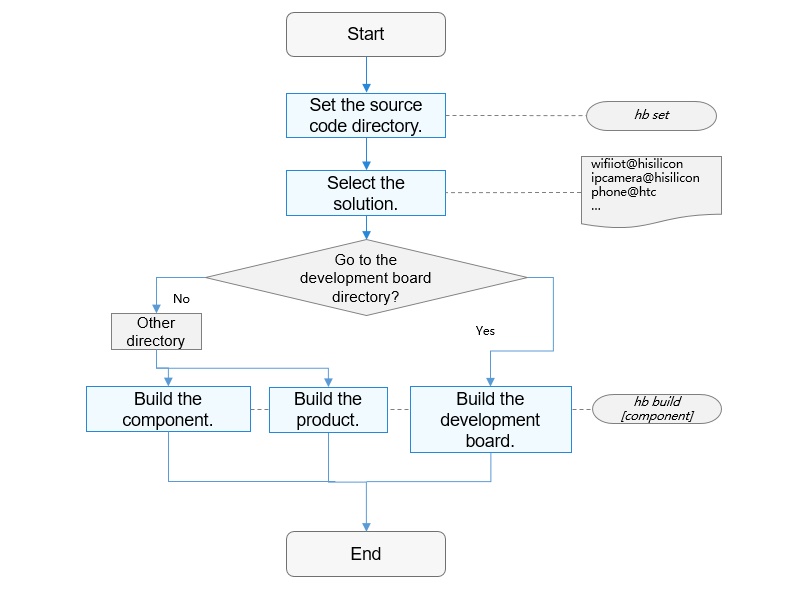7.6 KiB
Compilation and Building for Mini and Small Systems
Introduction
The compilation and building subsystem is a build framework based on Generate Ninja GN and Ninja, which supports component-based OpenHarmony development. This subsystem can be used to:
-
Build products.
-
Build chipset vendor components independently.
-
Build a single component independently.
It is considered best practice to learn the following basic concepts before you start development and build:
-
Component
A component is a reusable software unit that can contain source code, configuration files, resource files, and build scripts.
-
GN
GN is short for Generate Ninja, which is a build system used to generate Ninja files.
-
Ninja
Ninja is a small high-speed build system.
Build Process
The following figure shows the build process.
- hb set: Set the OpenHarmony source code directory and the product to build.
- hb build: Build the product, development board, or component. The process to build the solution is as follows:
- Reading configuration: Read the development board configuration, which covers the toolchain, linking commands, and build options.
- Running gn: Run the gn gen command to read the product configuration
related to the development board, kernel, and system componentsand generate the out directory and ninja files for the solution. - Running Ninja: Run ninja -C out/company/product to start build.
- Packaging: Package the build result to create a file system image.
Directory Structure
build/lite # Primary directory
├── components # Component description file
├── hb # hb pip installation package
├── make_rootfs # make script for the file system
├── config # Build configuration items
│ ├── component # Definitions of component-related templates, including static libraries, dynamic libraries, extension components, and emulator libraries
│ ├── kernel # Build configuration parameters of the kernel
│ └── subsystem # Subsystem template
├── ndk # NDK-related build scripts and configuration parameters
└── toolchain # Build toolchain, which contain the compiler directories, build options, and linking options
Usage
Usage Guidelines
-
Prerequisites
- Server and OS version: Linux server running 64-bit Ubuntu 16.04 or later
- Python version: 3.7.4 or later
- Repository: build_lite of OpenHarmony source code
-
Installing hb
-
Run the following command in the root directory of the source code:
python3 -m pip install --user build/lite -
Run the hb -h command. If the following information is displayed, the installation is successful:
usage: hb OHOS build system positional arguments: {build,set,env,clean} build Build source code set OHOS build settings env Show OHOS build env clean Clean output optional arguments: -h, --help Show this help message and exit -
Uninstalling hb
Run the following command to uninstall hb:
python3 -m pip uninstall ohos-build
-
-
Build Commands
-
hb set
hb set -h usage: hb set [-h] [-root [ROOT_PATH]] [-p] optional arguments: -h, --help Show this help message and exit. -root [ROOT_PATH], --root_path [ROOT_PATH] Set OHOS root path. -p, --product Set OHOS board and kernel.- If you run hb set with no argument, the default setting process starts.
- You can run hb set -root [ROOT_PATH] to set the root directory of the source code.
- hb set -p --product is used to set the product to build.
-
hb env
View the current configuration.
hb env [OHOS INFO] root path: xxx [OHOS INFO] board: hispark_taurus [OHOS INFO] kernel: liteos [OHOS INFO] product: ipcamera [OHOS INFO] product path: xxx/vendor/hisilicon/ipcamera [OHOS INFO] device path: xxx/device/hisilicon/hispark_taurus/sdk_linux_4.19 -
hb build
hb build -h usage: hb build [-h] [-b BUILD_TYPE] [-c COMPILER] [-t [TEST [TEST ...]]] [--dmverity] [-p PRODUCT] [-f] [-n] [component [component ...]] positional arguments: component Name of the component. optional arguments: -h, --help Show this help message and exit. -b BUILD_TYPE, --build_type BUILD_TYPE Release or debug version. -c COMPILER, --compiler COMPILER Specify compiler. -t [TEST [TEST ...]], --test [TEST [TEST ...]] Compile test suit. --dmverity Enable dmverity. -p PRODUCT, --product PRODUCT Build a specified product with {product_name}@{company}, eg: ipcamera@hisilcon. -f, --full Full code compilation. -T [TARGET [TARGET ...]], --target [TARGET [TARGET ...]] Compile single target- If you run hb build with no argument, the previously configured code directory, product, and options are used for build.
- You can run hb build {component} to build product components separately based on the development board and kernel set for the product, for example, hb build kv_store.
- You can run hb build -p PRODUCT to skip the setting step and build the product directly.
- You can run hb build in device/device_company/board to select the kernel and start build based on the current development board and the selected kernel to generate an image that contains the kernel and driver only.
-
hb clean
Clear the build result of the product in the out directory, and leave the args.gn and build.log files only. To clear files in a specified directory, add the directory parameter to the command, for example, hb clean xxx/out/xxx.
hb clean usage: hb clean [-h] [out_path] positional arguments: out_path Clean a specified path. optional arguments: -h, --help Show this help message and exit.
-
Repositories Involved
Compilation and building subsystem
